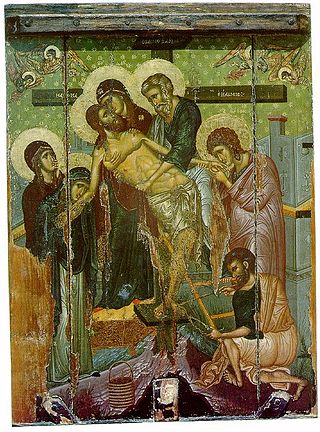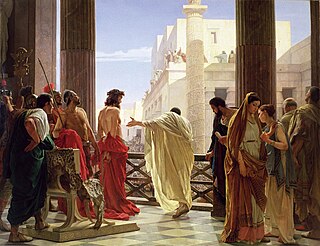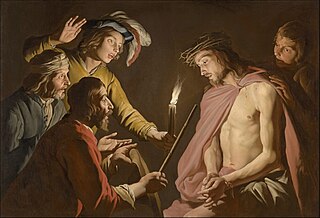
The Roman historian and senator Tacitus referred to Jesus, his execution by Pontius Pilate, and the existence of early Christians in Rome in his final work, Annals, book 15, chapter 44.

Saint Veronica, also known as Berenike, was a widow from Jerusalem who lived in the 1st century AD, according to extra-biblical Christian sacred tradition. A celebrated saint in many pious Christian countries, the 17th-century Acta Sanctorum published by the Bollandists listed her feast under July 12, but the German Jesuit scholar Joseph Braun cited her commemoration in Festi Marianni on 13 January.

Joseph of Arimathea was, according to all four canonical gospels, a Pharisee who assumed responsibility for the burial of Jesus after his crucifixion. The historical location of Arimathea is uncertain, although it has been identified with several towns. A number of stories that developed during the Middle Ages connect him with Glastonbury, England, and also with the Holy Grail legend.

Pontius Pilate was the fifth governor of the Roman province of Judaea, serving under Emperor Tiberius from 26/27 to 36/37 AD. He is best known for being the official who presided over the trial of Jesus and ultimately ordered his crucifixion. Pilate's importance in Christianity is underscored by his prominent place in both the Apostles' and Nicene Creeds. Because the gospels portray Pilate as reluctant to execute Jesus, the Ethiopian Church believes that Pilate became a Christian and venerates him as both a martyr and a saint, a belief which is historically shared by the Coptic Church, with a feast day on 19 or 25 June, respectively.

The Passion is the short final period before the death of Jesus, described in the four canonical gospels. It is commemorated in Christianity every year during Holy Week.

The Gospel of Nicodemus, also known as the Acts of Pilate, is an apocryphal gospel claimed to have been derived from an original Hebrew work written by Nicodemus, who appears in the Gospel of John as an associate of Jesus. The title "Gospel of Nicodemus" is medieval in origin. The dates of its accreted sections are uncertain, but the work in its existing form is thought to date to around the 4th or 5th century AD.

Herod Antipas was a 1st-century ruler of Galilee and Perea. He bore the title of tetrarch and is referred to as both "Herod the Tetrarch" and "King Herod" in the New Testament, although he never held the title of king. He was a son of Herod the Great and a grandson of Antipater the Idumaean. He is widely known today for accounts in the New Testament of his role in events that led to the executions of John the Baptist and Jesus of Nazareth. His father, Herod the Great, was alleged to have ordered the Massacre of the Innocents, marking the earliest Biblical account of the concerns of the government in Jerusalem regarding Jesus's existence.
The unnamed wife of Pontius Pilate appears only once in the Gospel of Matthew (27:19), where she intercedes with Pilate on Jesus' behalf. It is uncertain whether Pilate was actually married, although it is likely. In later tradition, she becomes known as Procula or Procla and plays a role in various New Testament Apocrypha. At a later date, she acquires the name Claudia Procula in Western tradition, as well as other names and variants of these names. She is venerated as a saint by the Eastern Orthodox Church, the Eastern Catholic Church, the Coptic Church, and the Ethiopian Church. She has also frequently been featured in literature and film.

The Revelation of Stephen or Apocalypse of Stephen is a text of New Testament apocrypha. It features Saint Stephen, one of the Seven Deacons to the Twelve apostles.

Luke 3 is the third chapter of the Gospel of Luke in the New Testament of the Christian Bible, traditionally attributed to Luke the Evangelist, a companion of Paul the Apostle on his missionary journeys. It contains an account of the preaching of John the Baptist as well as a genealogy of Jesus. From the start of this chapter until Luke 9:50, the "shape and outlook" of Luke's Gospel follow closely those of the other synoptic gospels, Matthew and Mark. The Expositor's Greek Testament states that in this chapter "the ministry of the new era opens".
The Lost Books of the Bible and the Forgotten Books of Eden (1926) is a collection of 17th-century and 18th-century English translations of some Old Testament Pseudepigrapha and New Testament Apocrypha, some of which were assembled in the 1820s, and then republished with the current title in 1926.
Matthew 28:14 is the fourteenth verse of the twenty-eighth chapter of the Gospel of Matthew in the New Testament. This verse is part of the resurrection narrative. In this verse the priests of Jerusalem assured the safety of the tomb guards should the governor, Pontius Pilate, receive report of their failure.

Matthew 27:2 is the second verse of the twenty-seventh chapter of the twenty-seventh chapter of the Gospel of Matthew in the New Testament. Jesus has just seen condemned by the Jewish Sanhedrin, and in this verse is presented to Pontius Pilate.
Siege of Jerusalem is the title commonly given to an anonymous Middle English epic poem created in the second half of the 14th century. The poem is composed in the alliterative manner popular in medieval English poetry, especially during the period known as the "alliterative revival", and is known from nine surviving manuscripts, an uncommonly high number for works of this time.

The Pilate stone is a damaged block of carved limestone with a partially intact inscription attributed to, and mentioning, Pontius Pilate, a prefect of the Roman province of Judea from AD 26 to 36. It was discovered at the archaeological site of Caesarea Maritima in 1961. The artifact is particularly significant because it is an archaeological find of an authentic 1st-century Roman inscription mentioning the name "[Pont]ius Pilatus". It is contemporary to Pilate's lifetime, and accords with what is known of his reported career. In effect, the inscription constitutes the earliest surviving, and only contemporary, record of Pilate, who is otherwise known from the New Testament and apocryphal texts, the Jewish historian Josephus and writer Philo, and brief references by Roman historians such as Tacitus.

Pontius Pilate is an Italian drama film from 1962, directed by Gian Paolo Callegari and Irving Rapper, written by Oreste Biancoli, starring Jean Marais and Jeanne Crain.

Vindicta Salvatoris is a text of New Testament Apocrypha that expands the story of the aftermath of Jesus's execution. It was often presented as a supplement to the Gospel of Nicodemus. The oldest known copies are two Latin versions of the Vindicta Salvatoris, both dated to the 8th or 9th centuries and likely when the work was authored. The work is thought to have been composed in southern France, perhaps the Aquitaine region.
Passion Gospels are early Christian texts that either mostly or exclusively relate to the last events of Jesus' life: the Passion of Jesus. They are generally classed as New Testament apocrypha. The last chapters of the four canonical gospels include Passion narratives, but later Christians hungered for more details. Just as infancy gospels expanded the stories of young Jesus, Passion Gospels expanded the story of Jesus's arrest, trial, execution, resurrection, and the aftermath. These documents usually claimed to be written by a participant mentioned in the gospels, with Nicodemus, Pontius Pilate, and Joseph of Arimathea as popular choices for author. These documents are considered more legendary than historical, however, and were not included in the eventual Canon of the New Testament.

The Pilate cycle is a group of various pieces of early Christian literature that purport to either be written by Pontius Pilate, or else otherwise closely describe his activities and the Passion of Jesus. Unlike the four gospels, these later writings were not canonized in the New Testament, and hence relegated to a status of apocrypha. Some writings were quite obscure, with only a few ancient textual references known today; they merely survived through happenstance, and may not have been particularly widely read by early Christians in the Roman Empire and Christians in the Middle Ages. Others were more popular. The most notable example was the Gospel of Nicodemus, which proved quite popular and influential in medieval and Renaissance Christianity.












